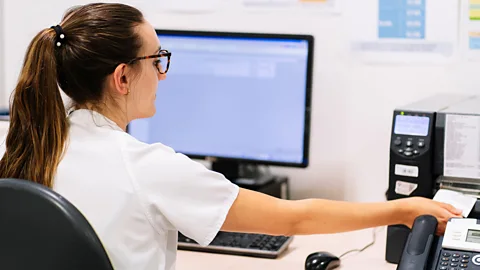The outdated machine hampering the fight against Covid-19
 Alamy
AlamyMajor backlogs in processing patient data during the pandemic are forcing the healthcare sector to reassess its relationship with fax machines.
As coronavirus cases surged in the city of Austin, Texas, last June, beleaguered public health officials instructed anyone with symptoms to act as though they had Covid-19. The reporting and tracing of new cases had slowed to a crawl, officials explained, partly due to an unexpected culprit: the fax machine.
The machines had kicked into overdrive as the pandemic tightened its grip on the city, spitting out printout after printout of results from Covid-19 tests. "We were probably getting thousands of cases a day that we were responding to. It was madness," says Janet Pichette, the chief epidemiologist for Austin Public Health. "You cannot fight a pandemic using 19th-Century technology."
More than a dozen staff combed through the stacks of printed facsimiles that at times piled up to 18cm (7 inches) thick, tasked with weeding out duplicates and tracking down any missing information. From there the results were manually entered into the city's tracking system.
Similar scenes were playing out around the world, highlighting the persistence of traditional fax machines in sectors such as healthcare, financial services and real estate, despite the global uptake of email, instant messaging and cloud computing. The inefficient sharing of data has left a growing number of governments promising to finally abandon their use of fax machines. More than 175 years after the technology was first patented and decades after it peaked as a must-have tool for businesses, could the coronavirus pandemic consign the fax machine to history?
You might also like:
The Ministry of Health in the Netherlands hopes so. In May it proposed legislation to parliament that would swap fax machines and DVDs for electronic formats in a bid to modernise how patient data is stored and accessed.
 Pascal Bachelet/BSIP/Alamy
Pascal Bachelet/BSIP/Alamy"It's really ridiculous that we actually still have fax machines, to be honest," says Monica Schagen, a policy advisor with the ministry and ed nurse.
But in some sectors, such as in healthcare, the fax machine has stubbornly clung on as way of sharing paper health records, test results and documents. Fax isn’t the only outdated technology used in hospitals – doctors rely heavily on pagers to respond to medical emergencies.
In the Netherlands, the need for change was clear during the pandemic. As hospital issions soared, healthcare workers lost valuable time tracking down patient records and test results. The Dutch healthcare sector has long grappled with the fact that the fax machine is almost obsolete in mainstream society, but vital to running a hospital.
"One of the first things that we teach our nursing students is how to use the fax machine," says Schagen. "Because it all comes together at the same time; you have a patient or two in the operating theatre, patients that are going for medical examinations at different departments and patients that need to be discharged and you're trying to how the fax machine works."
It's a paradox echoed across sectors such as real estate and financial services, where fax machines continue to whirl away despite being shunned by many as an archaic technology.
Others have remained loyal to the machine but updated it for the modern age, adopting technology that allows faxes to be sent and received in electronic formats.
"Society is amazingly complacent," says Kathryn Brohman, an associate professor at Queen's University in Kingston, Canada. "You think about inertia, always doing it the same way, and every doctor's office had a fax machine and every pharmacy had a fax machine and the infrastructure was all there.
"It's the whole idea of 'If it's not broken, why fix it">window._taboola = window._taboola || []; _taboola.push({ mode: 'alternating-thumbnails-a', container: 'taboola-below-article', placement: 'Below Article', target_type: 'mix' });
